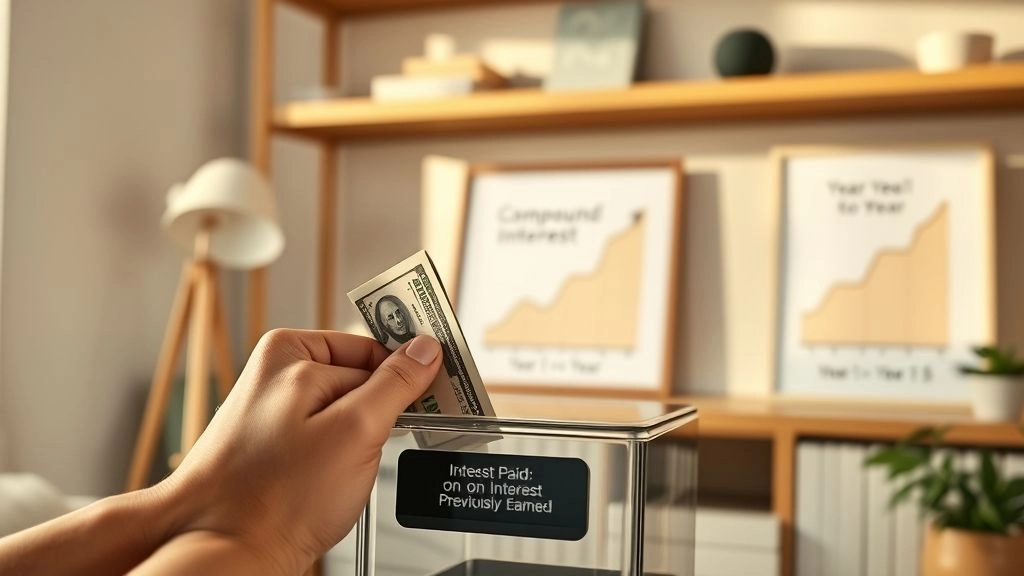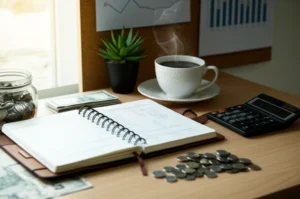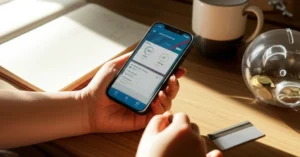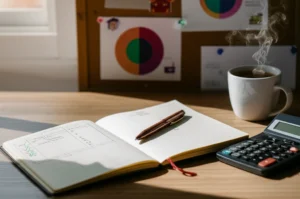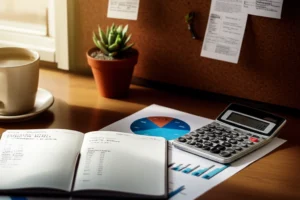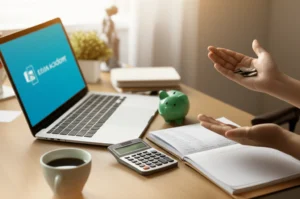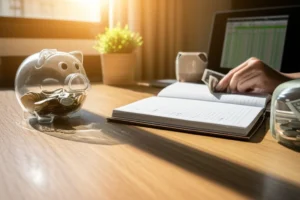Wait, Is Your Money Really Working for You?
Let’s pause for a second… When was the last time you checked your savings account and felt actually excited? Not “It’s something” excited, but that quiet little thrill—like, oh hey, my balance jumped and I didn’t need to do a thing? If that sounds like a unicorn, you’re in good company. Most of us weren’t taught how to let money do the heavy lifting. But here’s where things get interesting (pun 100% intended): That feeling isn’t out of reach. It’s called interest paid on interest previously earned. It’s simpler (and more powerful) than it sounds.
Picture this: you tuck away a few dollars every month, forget about it, and suddenly, five years later, it’s grown—not just from what you put in, but from what your money did all by itself. Magic? Almost. But it’s absolutely real. I’m talking about compound interest—today, let’s get cozy with how it works and why frugal folks like us can make it our secret superpower.
This Snowball Doesn’t Melt
So… What’s So Special About Compounding Anyway?
Okay, short and sweet: interest paid on interest previously earned means you earn interest not just on what you put in originally, but on the interest your money already earned. It’s interest on interest, building, rolling, sort of like a snowball gathering more snow as it goes downhill. Tiny at first, then suddenly…it’s got momentum you can feel.
Let’s peek at the difference. With simple interest, you only get paid for what you originally set aside. Set it and forget it, and it just kind of plods along. But compound interest? That’s where the magic kicks in. Every time your account earns a bit—say 5% interest—it tucks that new cash into your pile for next time. Next year, the 5% isn’t just on your first dollar. It’s on everything.
Table: Simple vs. Compound Interest Over 10 Years
| Year | Simple Interest ($500 at 4%) | Compound Interest, Compounded Quarterly ($500 at 4%) |
|---|---|---|
| 1 | 520 | 520.30 |
| 5 | 600 | 608.92 |
| 10 | 700 | 742.97 |
Those extra bucks? That’s compound interest at work. Over decades, it’s not just a few dollars—it can be hundreds, even thousands. If you’re a nerd like me, you’ll love playing with this on a calculator. If not, just trust this: the longer you let money rest, the wilder the snowball gets.
Compounding’s Secret Sauce
How Often Does Compounding Happen… And Why Should You Care?
Here’s a curveball: it’s not just how much you save, it’s how often your money gets to compounding. Monthly, quarterly, or even daily—every little increase in frequency lets your stack of cash build a teensy bit faster.
If you’re like most of us, you don’t stare at bank ads and think, “Ooh, compounded quarterly!” But say your account compounds daily? Even if you never stuff in more money, your balance grows at a slightly sharper curve than a yearly compounding account. It’s like leveling up your savings—without ever remembering to save more.
Real Life: Watching Pennies Turn to Dollars
Here’s where I get personal: years ago, I switched my lazy savings from a “plain-old” account (yearly compound, tiny interest) to a high-yield savings that offered compounding daily. Honestly, I expected maybe ten bucks extra if I was lucky. But after a year? It was almost $200 higher than I’d ever seen before. That was my streaming budget for the year right there—earned in my sleep, just because I looked for a compounding schedule that worked harder. Wild, right?
From Tight Budgets to Big Wins
Small Moves, Real Growth
Say, “budgeting” and everyone thinks hard work, spreadsheets, sacrifice. But what if the real win was getting money working for you… even if you start tiny?
This is where In The Five Foundations what is the Third Foundation comes up: Having an emergency fund. Think of it as the seed potato for compound interest. Build that small fund, let the compounding do its thing, and it doesn’t just protect you from nasty surprises (like flat tires or a chipped tooth). It starts to quietly grow.
Honestly, interest paid on interest previously earned pairs perfectly with frugality. Wherever you can cut some waste—home-brewed coffee, that forgotten gym membership—send those stray dollars to your savings. Not only are you growing your emergency fund, but those dollars begin to multiply.
Tip: Three Reasons To Save (and How Compounding Boosts Them)
- The three reasons to save money are security (hello, not freaking out over a lost job), opportunity (grabbing that flight deal or investment), and peace of mind (no more money nightmares).
- With compounding, you get all three. Each dollar set aside is a step away from stress…and the sooner you start, the further each step takes you.
On the Flip Side: Debt’s Compound Trouble
When Compounding Works Against You
Here’s the catch—compounding isn’t just a saver’s dream. It’s a nightmare when you owe, not own, that growing pile. Think credit cards or payday loans. They don’t just take your money. They pile up interest, then charge you interest on that interest too.
Ringing a bell? I’ve been there. Once, one late payment spiraled way past what I expected. Suddenly, there’s not just a late fee, but that whole sum starts earning (for the bank, not me). That’s why if you make a late credit payment, you might see the lender add fees and watch the compounding hurt instead of help. It’s brutal. My tip? Knock out debt ASAP. Pay it off—and then put those same dollars to work in a real compound-friendly savings account instead.
Table: Savings Compounding vs. Debt Compounding
| Scenario | Compounding Rate | 5-Year Growth/Loss |
|---|---|---|
| High-Yield Savings | 5% annually | $5,000 grows to $6,381 |
| Credit Card Debt | 18% annually | $5,000 balloons to $11,415 owed |
That’s… not a typo. Debt compounds fast. That’s the evil twin to our friend in savings. If this table makes you uneasy—good. It made me rethink every “treat yourself” swipe until debt was gone for good.
Easy Tools & Boringly Effective Habits
No Math Genius Needed
Here’s the thing: You don’t need to be a calculator wizard. There are so many online calculators where you plug your numbers in (just Google “compound interest calculator”)—eat your popcorn, let the algorithm do the rest. Suddenly those “boring” $20s you slip into savings look powerful.
But don’t overthink it. Start by asking yourself: How much can I set aside every month without missing it? Maybe just tap into a daily habit—pack lunch instead of eating out, carpool with a friend, or downgrade just one subscription. Then, send what you save into your interest-bearing account and let compounding work while you sleep.
Wait, Where Should I Put My Money?
You’ve got options. Basic savings work, but high-yield accounts, CDs (certificates of deposit), and money market accounts are even better for frugal savers. High-yield savings are usually the friendliest—easy to access, no crazy withdrawal penalties, and the compounding is often daily or monthly. CDs lock your money (and sometimes offer higher rates), but penalties hurt if you pull out early. Don’t forget about stocks or dividend mutual funds either; when you reinvest those dividends, your cash keeps doubling down. Check out this simple breakdown from the Consumer Financial Protection Bureau if you want real-life calculator visuals.
And hey, if you don’t know which to pick, don’t sweat it. Even a low-interest savings account is better than cash under the mattress. The trick is to just start—now is always better than “someday.”
Your Frugal Wins, Multiplied
Keep It Simple, Celebrate Small Progress
Let’s recap—in the gentlest, most honest way: interest paid on interest previously earned gives frugal folks like us a major advantage. We don’t have to save big to see real growth. Each little act of everyday thrift is a building block. Every coffee brewed, every sale snagged, every errand done by bike—those baby steps are the fuel for your financial snowball.
I’ll be real: my first ever “interest burst” was less than $10. But it felt like winning the lottery. Over time, the numbers got bigger and I got braver—upped my savings bit by bit. I celebrated by grabbing my favorite store-brand ice cream (on sale, obviously) and didn’t feel one bit deprived. That’s frugality: putting joy right alongside smart habits so you want to keep going.
Please, don’t get hung up on the perfect number or how much your neighbor puts away. Start wherever you are. Don’t let anyone shame you for beginning small. If you’ve wondered why is it important to make an emergency fund your first financial priority—it’s because it lets you sleep better and watch your savings gently multiply, one dollar and one week at a time.
Here’s to Your Tiny Snowball
So, where does this all leave us? Whether you’re socking away $5 or $500 a month, interest paid on interest previously earned is working quietly in your corner. The trick is to get started—and then let inertia, not effort, keep things rolling. Fight the urge to obsess. Enjoy those small wins. Tell your future self “you’re welcome” every time you skip a splurge and instead deposit that cash. And hey—share your own savings “aha!” moments below. Let’s cheer for every step, every dollar grown, every lesson learned. We’ve got this, friend. And five years from now, you’ll be so glad you let time and compound interest take the wheel.

